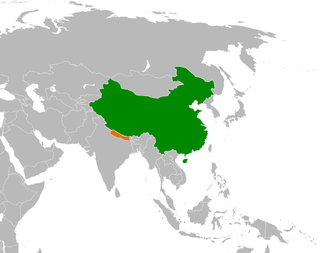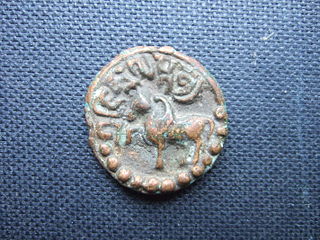Related Research Articles

Nepal is a multi-ethnic, multiracial, multicultural, multi-religious, and multilingual country. The most spoken language is Nepali followed by several other ethnic languages.

Princess Bhrikuti Devi of Licchavi is the first wife and queen of the emperor of Tibet, Songtsen Gampo, and an incarnation of Green Tara. She was also known as "Besa", and was a princess of the Licchavi kingdom of Nepal. She became the queen consort of Tibet c. 622.

Harshavardhana was a Pushyabhuti emperor who ruled northern India from 606 to 647 CE. He was the son of Prabhakaravardhana who had defeated the Alchon Hun invaders, and the younger brother of Rajyavardhana, a king of Thanesar, present-day Haryana.
Amshuverma or Amshu Verma was a king of Nepal from around 605–621 CE. Initially a feudal lord, he rose to the position of Mahasamanta in about 598 CE when Shivadeva I of the Licchavi dynasty was the ruling monarch and by 604, Shivadeva was reduced to a mere figurehead. He is considered to have died in 621 AD and was succeeded by Udaydeva, the son of Shivadeva I.

Songtsen Gampo, also Songzan Ganbu, was the 33rd Tibetan king and founder of the Tibetan Empire, and is traditionally credited with the introduction of Buddhism to Tibet, influenced by his Nepali consort Bhrikuti, of Nepal's Licchavi dynasty, as well as with the unification of what had previously been several Tibetan kingdoms. He is also regarded as responsible for the creation of the Tibetan script and therefore the establishment of Classical Tibetan, the language spoken in his region at the time, as the literary language of Tibet.
The first military conflict between China and Tibet occurred in 638. In the early 7th century, the westward conquests of the Tang dynasty brought it into contact with the rising Tibetan Empire. When Emperor Taizong of Tang refused a marriage alliance, the Tibetan emperor Songtsen Gampo sent an army to attack the Chinese frontier city of Songzhou. After a Tang army inflicted heavy casualties on the Tibetans in a night-time attack, Songtsen Gampo withdrew. He sent emissaries and tributes to Chang'an to apologize, and to again request marriage. Taizong decided to give Songtsen Gampo a distant niece, Princess Wencheng, in marriage. The peace held for the remainder of the reigns of Taizong and Songtsen Gampo, although Tibet would pose major military threats for most of the rest of the Tang period.
Wang Xuance was a Chinese diplomat, military general, and travel writer. In 648, Tang Taizong sent him to India in response to Harshavardhana sending an ambassador to China. However once in India he discovered Harshavardhana had died and the new king Aluonashun attacked Wang and his 30 mounted subordinates. This led to Wang Xuance escaping to Tibet and then mounting a joint of over 7,000 Nepalese mounted infantry and 1,200 Tibetan infantry and attack on the Indian state on June 16. The success of this attack won Xuance the prestigious title of the "Grand Master for the Closing Court." He also secured a reported Buddhist relic for China. 2,000 prisoners were taken from Magadha by the Nepali and Tibetan forces under Wang. Tibetan and Chinese writings document describe Wang Xuance's raid on India with Tibetan soldiers. Nepal had been subdued by the Tibetan King Songtsen. The Indian pretender was among the captives. The war happened in 649. Taizong's grave had a statue of the Indian pretender. The pretender's name was recorded in Chinese records as "Na-fu-ti O-lo-na-shuen". The war had lasted 3 days.

The bilateral relation between Nepal and China is defined by the Sino-Nepalese Treaty of Peace and Friendship signed on April 28, 1960, by the two countries. Though initially unenthusiastic, Nepal has been of late making efforts to increase trade and connectivity with China. Relations between Nepal and China got a boost when both countries solved all border disputes along the China–Nepal border by signing the Sino-Nepal boundary agreement on March 21, 1960, making Nepal the first neighboring country of China to agree to and ratify a border treaty with China. The government of both Nepal and China ratified the border agreement treaty on October 5, 1961. From 1975 onward, Nepal has maintained a policy of balancing the competing influence of China and Nepal's southern neighbor India, the only two neighbors of the Himalayan country after the accession of the Kingdom of Sikkim into India in 1975.

During Tang dynasty rule in China (618–907), a complex relationship between imperial China and Tibet regime was developed. During this period Chinese and Tibetan forces had many battles since both parties were military powers, but there were also years of peace and friendly relations.

The history of the city of Kathmandu, which is inseparable from that of the Kathmandu valley, dates back to ancient times.

Pratap Malla was a Malla king and the eighth King of Kantipur from 1641 until his death in 1674. He attempted to unify Kathmandu Valley by conquering Lalitpur and Bhaktapur, but failed in the effort. He was successful in extending and securing the borders of Kantipur and was responsible for the monopoly over trade with Tibet. The resulting prosperity was responsible for the construction of majority of the buildings around Durbar Square during his reign. His reign is seen as a cultural and economical high point of the Malla dynasty.
The earliest coin minted in today's territory of Nepal was in Shakya Mahajanapada, along the India–Nepal border at around 500 BCE. Shakya coins were an example of a coin invented in the Indian subcontinent which continued to be used in Nepal alongside India for over 1500 years.

Bhim Shumsher Jung Bahadur Rana ruled Nepal from 26 November 1929 until his death on 1 September 1932. He was born on 16 April 1865.
Arunāsva, also known as Aluonashun by the Chinese, ruled Tirhut, Kannauj, and the surrounding area for a brief period after Harshavardhana, who died heirless. He usurped the throne, succeeding the Pushyabhuti dynasty. He is known for repulsing an invasion launched by the Arab Muslims of the Rashidun Caliphate.
In the 11th century, a powerful empire of Khas people emerged in western Nepal whose territory at its highest peak included much of western Nepal as well as parts of western Tibet and Uttarakhand of India. By the 14th century, the empire had splintered into loosely associated Baise rajyas, literally 22 states as they were counted. The rich culture and language of the Khas people spread throughout Nepal and as far as Indo-China in the intervening centuries; their language, later renamed the Nepali language, became the lingua franca of Nepal as well as much of North-east India. In south-eastern Nepal, Simraungarh annexed Mithila around 1100 AD, and the unified Tirhut stood as a powerful kingdom for more than 200 years, even ruling over Kathmandu for a time. After another 300 years of Muslim rule, Tirhut came under the control of the Sens of Makawanpur. In the eastern hills, a confederation of Kirat principalities ruled the area between Kathmandu and Bengal.
Jayadeva II was the son of Shivadeva II and a king of the Licchavi dynasty who ruled Nepal from 713 to 733 CE.

Jishnu Gupta, often spelled Jishnugupta, was a de facto ruler of Nepal in the 7th-century during the time of the Lichchhavi dynasty. Initially sharing the administrative powers with Dhruvadeva from 624 CE, he became the highest authority in the realm from around 627. He belonged to the Abhira-Gupta dynasty.
Udaydeva was the son of Shivadeva I and a Lichchhavi king of Nepal. He succeeded Amshuverma in 621 CE but was soon ousted by Jishnu Gupta, and his brother Dhruvadeva. He is also believed to be the father of Bhrikuti.
Dhruvadeva, also spelled Dhruva Deva, was a son of Shivadeva I of the Licchavi dynasty and a king of Nepal in the 7th century. He deposed his brother Udaydeva with the help of Jishnu Gupta and reigned as a figurehead monarch.
Bhimarjunadeva was a son of Dhruvadeva of the Licchavi dynasty and a king of Nepal in the 7th century. He succeeded his father in c. 630 and reigned as a figurehead monarch.
References
- 1 2 3 4 Shrestha, D.B.; Singh, C.B. (1972). The History of Ancient and Medieval Nepal (PDF).
- ↑ Shrestha, Nanda R. (2003). Historical dictionary of Nepal. Keshav Bhattarai. Lanham, Md.: Scarecrow Press. ISBN 0-8108-4797-3. OCLC 51931102.
- 1 2 3 4 5 6 7 Shaha, Rishikesh. "Ancient and Medieval Nepal". University of Cambridge.
- ↑ Sen, Tansen (2003-01-01). Buddhism, Diplomacy, and Trade: The Realignment of Sino-Indian Relations, 600-1400. University of Hawaii Press. ISBN 978-0-8248-2593-5.
- ↑ Charles D. Benn (2002). Daily life in traditional China. Internet Archive. Greenwood Press. ISBN 978-0-313-30955-7.